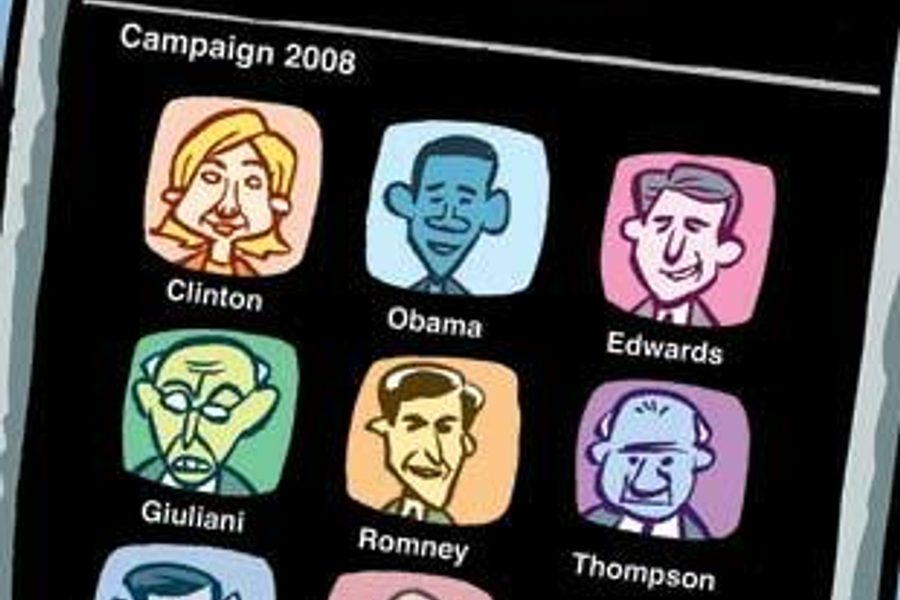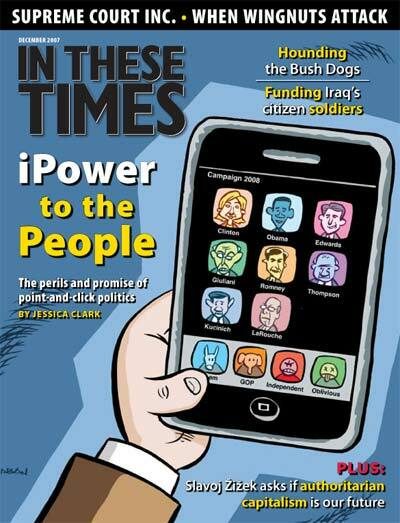
Grinning like a rock star, Democratic presidential candidate John Edwards strides out to a lighted platform in the center of a townhall gathering at the University of New Hampshire. With his glossy ‘do flanked by the neon red-and-blue lightening bolts of the “Choose or Lose” logo affixed to the wall, Edwards nods and pauses to make deliberate eye contact with students in the audience. It’s a made-for-MTV moment.
The first in a series of MySpace/MTV “presidential dialogues,” the feel and format of this late-September forum stands in stark contrast to the previous night’s party-sanctioned Democratic debate at Dartmouth College in New Hampshire. At that one, moderator Tim Russert controlled the debate with a firm hand. But pandering to the youth vote is nothing new – what sets this event apart is the way viewers interact with candidates.
Like other rejiggered debates in this campaign cycle, the ongoing MySpace/MTV presidential dialogues are the product of two forces reshaping voters’ engagement with candidates. The first is a growing disgust with the mainstream press, expressed most strikingly by the surging popularity of citizen-generated media. The second is a public call for greater political access in the face of an imperial presidency and a weak Congress. The hope is that participatory politics will counteract voter apathy that results from top-down politics.
If we’re to believe the hype, this is a banner moment for unmediated political action.
“Tired of scripted old-style presidential debates?” boasts the presidential dialogue webpage (www.myspace.com/election2008). “MySpace and MTV join forces to empower you to ask questions directly to top presidential candidates and respond to their answers in real time.” This rhetoric of self-determination can get bossy: “Declare Yourself!” screams a blinking graphic. “Ask Questions!” advises a widget that allows users to launch MySpace’s instant messaging (IM) software. “Spread the Word!” urges a tool that lets users link to the forum from their profile pages.
And, most importantly: “Vote.” In the lingua franca of today’s participatory politics, clicking on a button translates into democracy.
MTV correspondents Gideon Yago and SuChin Pak work the crowd. Yago announces that there will be “no delays, no censors, no tasers.” Washington Post reporter Chris Cilizza fields IM questions and weighs in on live polling data. He seems put out being the mouthpiece for chatroom personae like “LunarGoddess68,” who has a question about Edwards’ education plan. Edwards answers even the most esoteric of student questions directly, and gamely responds to Cilizza’s awkward interjections about real-time viewer response pie charts.
Viewers rate candidate responses with either “like it” (clicking buttons that indicate the candidate answered questions, understands reality or has good ideas) or “don’t like it” (buttons that indicate the candidate dodged questions, is out of touch, has wrong ideas). As these things go, Edwards’ appearance is a success. By the end, 94 percent of online respondents have given him “like it” ratings. Yet, MTV says, of the 2,300 people who submitted questions online, only three make it into the discussion.
From the point of view of candidates, this format is useful. Why pay for focus groups when you can crowdsource feedback for free? MySpace wins big too, gaining a seat at the table as an arbiter of presidential power. And MTV accrues gravitas to balance its other MySpace-inspired production: “A Shot at Love with Tila Tequila” (which promises viewers “hair pulling … ball-busting and, er, even some butt waxing”).
But what about voters? Are we feeling empowered yet?
Democracy in the Internet age, baby
For decades, broadcast outlets have been both voters’ main conduit to the candidates and the major financial beneficiaries of political campaigns. By the time the 2008 election rolls around, politicians and their allies will have spent $3 billion on advertising in traditional broadcast media, according to an April report from Wachovia Capital Markets.
But with user-driven digital platforms now quick at the heels of broadcasters, legacy journalism outlets are partnering with search engines, video-sharing sites and social networks in an attempt to remain relevant while still retaining the driver’s seat.
July’s CNN/YouTube presidential debate (www.youtube.com/debates) offered a hybrid of new media and old gatekeepers. YouTube users submitted nearly 3,000 video questions for Democratic candidates – including one from a climate-change obsessed snowman. Moderated by journalist Anderson Cooper, the debate featured 39 of them.
Critics like Matthew Yglesias, a blogger and associate editor at The Atlantic Monthly, complained that mainstream outlets are violating the open spirit of online communication. “Instead of delivering some sort of Politics 2.0,” Yglesias wrote in the July 25 Guardian, “the [CNN/YouTube] debate only provided a further level of mediation between citizen and politician. The professional journalists portrayed themselves as liberated from any need to serve higher analytic functions … The questions themselves, meanwhile, tended to differ from the norm only by being more absurd and featuring performances of folksiness.”
But the debate’s broadcast was only part of the story. The submission of thousands of videos signaled the rising expectation that politicians can – and should – answer voters’ questions.
After the broadcast, Community Counts, a site made up of volunteers who met on YouTube (www.communitycounts.us), launched a campaign to pressure candidates to respond to unanswered videos. Led by high school physics teacher David Colarusso, the site invited users to rank the questions. Several candidates answered the top-ranking ones, and users are already voting on videos submitted for the Nov. 28 CNN/YouTube Republican debate.
As James Koteki (YouTube name: EmergencyCheese) notes in the launch video for the Community Counts site, “It’s democracy in the Internet age, baby.”
Not your mother’s media
Media and campaign professionals are right to be nervous about these new formats. Bloggers, podcasters and vloggers have served as reporters and commentators for several years, and now they are edging up as debate moderators. In mid-September, Yahoo! co-organized a “Democratic Candidate Mashup” with The Huffington Post and Slate (debates.news.yahoo.com). The mashup gave users a seat in the producer’s chair, letting them choose from pre-recorded questions that journalist Charlie Rose and talk-show host Bill Maher posed to candidates.
The remixed debates are proving popular. While the selection of questions may limit the range of political discussion, the CNN/YouTube format is more entertaining than the standard, straitlaced snoozefest – a boon if the goal is basic voter engagement. According to Nielsen Media Research, the two-hour July broadcast delivered a higher viewership among adults between the ages of 18 and 34 than any other debate in cable history. And the on-air broadcast of the Edwards MySpace/MTV presidential dialogue was the number-one program for cable viewers aged 18-24 for that time slot.
But while these experiments open the floor for new voices and new questions, it’s not as though citizen journalists have suddenly gained a mass audience, or that voters have traded broadcast consumption for face-to-face access to candidates. Instead, a fresh set of corporate powerbrokers is now mediating the relationship between audience and politician.
MySpace (owned by conservative media baron Rupert Murdoch), YouTube and Blogger (both owned by Google), and other similar platforms, are large commercial websites that harness citizen-driven media to draw ad share and position themselves in a hot investment market. While everyday people may be producing political media out of their own passion and sense of civic urgency, corporate sites are cashing in on their labor. And the ever-more-precise tailoring of Web content to consumer interests is raising privacy concerns.
Corporations such as Microsoft, Yahoo!, Time Warner and Google were among those spending more than $33 billion in “an ad industry-focused merger and acquisition spree,” writes Jeff Chester of the Center for Digital Democracy in a recent article in The Nation. They’ve dropped “big bucks to acquire firms that collect, analyze and target us largely via stealth and highly sophisticated interactive ad technologies.”
This Web 2.0 bubble is still far from bursting. More than half of all Americans between the ages of 12 and 17 use some online social networking site such as MySpace or Facebook, according to a survey by the Pew Internet and American Life Project. In late October, Microsoft announced that it would pay MySpace rival Facebook $240 million for a mere 1.6 percent stake in the site. This may not be your mother’s media, but it’s still big business.
Some foundations are getting into the digital mix, underwriting both for-profit and nonprofit media experiments that offer more open-content models. Leading the charge is the John S. and James L. Knight Foundation, which, in 2006, awarded MTV $700,000 for its plan to place a young reporter in every state to create weekly cell-phone videos on the election and other political issues.
Knight also partnered with MTV (and its corporate owner Viacom) on a “Young Creators” award (www.youngcreatorsaward.com), which will give up to $500,000 to innovators under 25 who have a winning proposal for a digital news project that helps to build community. The contest closed in mid-October.
“The idea that MTV should be subsidized for contributing to public service is wrongheaded,” Chester wrote on his blog at the Center for Digital Democracy. “Journalism foundations such as Knight and [journalism schools] should be holding the media industry’s editorial feet to the fire, shaming them to spend more money on serious journalism.” But what that serious journalism might look like in this environment is still unclear.
Disintermediated Democrats
User-driven online platforms are not only reshaping the media landscape but shaking up the way candidates communicate with voters. Digital tools played a signal role in the 2004 election, and tools have now permeated other facets of election planning, from communications to fundraising to field operations.
Less than a year out from the election, the presidential campaigns are in R&D mode, experimenting with digital engagement tools while still trying to maintain obligations to older forms of political communication. This tension is reflected in the proliferation of debate formats.
On the Democratic side, the September Dartmouth debate was one of six approved by the Democratic National Committee (DNC) through the end of 2007. As tradition would have it, the party organized all six in conjunction with at least one mainstream news network.
For their part, advocacy groups have been partnering with niche cable channels to host debates that hone in on particular issues. Since April, the Democratic candidates have tangled at two historically black colleges and the NAACP convention, at the YearlyKos and AFL-CIO gatherings in Chicago, on LGBT channel LOGO and Spanish-language channel Univision, and on PBS in conjunction with AARP.
But the proliferation of debates has robbed these proceedings of some of their thunder. In a more closed mainstream echo chamber, for example, the debate on gay and lesbian issues would have likely generated an uproar that resonated through the rest of the election. However, in our multichannel, multiplatform world, such narrowcast debates no longer carry the same emblematic heft.
While special-interest organizations still stand as a proxy between citizens and candidates, online participatory campaigning promises to reduce the degree of separation and artifice to nearly nil. In the business world, this is known as “disintermediation” – or cutting out the middleman. Its star pupil is Amazon.com, which has disintermediated many an independent bookstore out of existence.
Advocates of participatory politics bemoan the fact that civil rights, environmental and consumer protection organizations that once depended on the support and convictions of their members have ossified into Beltway-bound fundraising machines, more interested in obtaining direct mail lists than in working together to advance movements for change.
“Political power is more and more situated in far-flung networks that can be activated and deactivated quickly,” writes blogger and online organizer Matt Stoller at OpenLeft.com. “And the new millennial generation that will be the political backbone for the new progressive America likes it this way.”
Techpresident.com – a group blog managed by the Personal Democracy Forum, a site that explores the ways that technology is changing politics – tracks the use of online social networking tools by the campaigns. The Obama campaign, especially, has aggressively pursued voters via online tools. As of Sept. 28, it was leading all other Democratic candidates. (See chart.)
In addition to Obama’s sizeable MySpace and Facebook presence, his campaign has developed its own active social network, MyBarackObama.com. And by mid-October, the campaign had attracted more than 180,000 friends on the niche social network site BlackPlanet.com.
By recruiting “friends” on both broad and targeted social networks, and then offering campaign-focused tools on its own site, the Obama campaign is providing online channels for individual voters to become more involved. Social networks also allow users to bond with one another, creating a different kind of connection to the campaign. Forging such personal ties can be as – if not more – important to voters than appealing to them on policy positions. As psychologist Drew Westen writes in The Political Brain: The Role of Emotion in Deciding the Fate of the Nation, “In politics, when reason and emotion collide, emotion invariably wins.”
Of course, the role of these technologies in politics is still evolving, and entertainment still trumps politics online. To the chagrin of the other candidates, comedian Stephen Colbert’s late bid for the presidency led a Facebook group called “1,000,000 Strong for Stephen T. Colbert” to gather more than 1 million members in just over a week, overstretching the site’s servers and becoming its most popular political destination.
Building a better debate
For political observers like Micah Sifry, co-founder of Personal Democracy Forum (PDF) and editor of Techpresident.com, the more online access that voters have to candidates and to one another, the better. A long-time political writer and expert on third-party politics, Sifry first sensed a shift in the dynamics of voter engagement during the 2004 race, when his brother David Sifry, founder of blog search engine Technorati, dragged him to a conference of open source programmers, social software developers and science fiction writers. There he found kindred spirits.
“It felt like a gathering of the tribes,” says Sifry. Even though the Dean campaign had just collapsed, there was “a lot of excitement about how technology was going to change the structure of politics.”
Sifry noticed that conference participants were using chat tools to communicate about the conference live. Known as a “backchannel,” such conversations can quickly evolve into online content, broadening access to events. After that experience, Sifry found traditional political conferences as out of step. “The progressive side is playing its game in a very old way,” he says. “Middle-class progressives are very unaware of how elite their styles are.” This insight led him to work with entrepreneur and technology consultant Andrew Rasiej to co-found PDF.
Even online, candidates are engaging in a style of “campaign management that is still top-down and cautious,” Sifry says. The key to analyzing experiments like the MySpace debate is “judging whether or not there’s some change in the normal conversation with a candidate. People can e-mail in questions; so what? People have been able to use 800 numbers for years. The question [is] how it changes the dialogue.”
PDF is taking a shot at changing the dialogue with its own presidential forum, 10Questions (www.10Questions.com). The group worked with Colarusso from Community Counts to build on his video voting site. Although the New York Times editorial board and MSNBC.com will present top-ranked questions to candidates, the questions won’t be filtered through a journalist. Instead, users can post questions on a variety of video sharing platforms – including YouTube, MySpace, Yahoo Video and Blip.tv – and tag them as “10Questions” to be included for consideration. Audience members for the site will then vote on the 10 best questions and candidates will be invited to post video answers through the end of the year.
Compared to the hyperbole of the MySpace presidential dialogue page, the 10Questions site is low key. The requisite red-and-blue design elements are there, but a basic grid of videos with thumbs up/thumbs down logos are set against a plain white background. So far, the most popular videos seem serious.
Third party candidates are welcome to submit their answers, too, as long as their party “has achieved or is likely to achieve a line on the ballot in enough states to hypothetically win an electoral-college majority.” The site does not accept advertising, and sponsorship is free. Sponsors range from conservative pundit Michelle Malkin to the Capitol Hill tabloid Politico to lefty radio station Air America.
Rasiej, who is funding 10Questions out of his own pocket, says “the political system is going through massive changes.” He notes the Internet now serves as the “ringmaster” for election coverage, unlike in previous elections when professional journalists primarily covered politics. And he suggests that reporters set context and point audiences to quality sources of online information instead of serving as gatekeepers. “The power is in the hands of the voter,” he says.
But participatory online politics are a partial solution for engaging a broad swath of the electorate. While the barriers to entry for citizens who want to create media or become involved in campaigns have dropped dramatically in the last few years, such activities still require time, equipment and online access – not to mention inclination. Getting people interested in elections is an uphill battle, especially if they feel alienated by politics-as-usual. The bulk of do-it-yourself digital media has little to do with political issues and even less to do with presidential campaigns.
For example, as of Oct. 26, of the 83 questions posted to 10Questions, only two videos were from participants who aren’t white. This reflects no prejudice on the part of the site’s organizers, but rather a structural gap in the demographics of online politics. The assumptions of the site – that presidential politics are relevant to the lives of ordinary citizens, that candidates will answer the questions posed to them and that they’ll tell the truth when they do – may hold little appeal to voters who have too often been marginalized in elections.
Social justice activists have found their own online tools for mobilizing constituencies and applying pressure to politicians from outside the system. In mid-September, more than 10,000 people travled to Jena, La., to protest the racially biased sentencing of six black students. Online organizing – across platforms such as ColorOfChange.org, the African-American blogosphere, YouTube and Wikipedia – was central to mobilizing this groundswell. “The big-name civil rights figures had to scramble to catch up with Jena,” writes Matt Compton in the online journal The Democratic Strategist. “[T]he organizing came together from the bottom up.” The model resonates far beyond the point-and-click polling of online democracy.
While opening political discussion through digital tools is worthwhile, virtual democracy neeeds broader reforms to address basic inequities in the political system. Many barriers remain: from laws passed in more than a half-dozen states (including Florida and Ohio) that discourage groups like the League of Women Voters and ACORN from running voter registration drives, to lingering questions about vote fraud involving electronic ballot machines, to the disproportionate influence that the electoral college system grants to voters in “swing states.” If as much was being invested in opening up our voting system as is in opening up our media system, real change could happen.
It’s one thing to engage voters. It’s another to enfranchise them. When both happen, we can start talking about empowerment.







